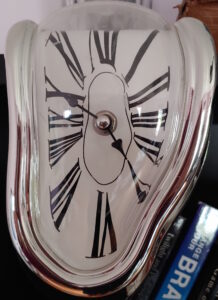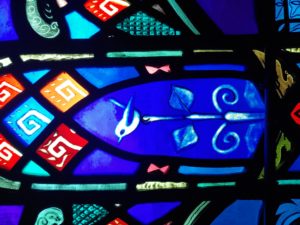I read it in January, 1990; the several days of snow, ice, and subzero temperatures that stranded me in East Machias, Maine, for a week gave me the time and incentive slog my way through. To this day, the cover art of A Brief History of Time makes me think of icy roads, the warmth of a wood stove, and just how hard it was to understand Hawking’s words and diagrams.
Chapter nine was all about time, and how it seems to flow – not just one kind of time, but three: how things are constantly moving toward chaos and disintegration (entropy), how things move from past through present toward the future (psychological time), and how time moves with the expanding universe (cosmological). Will the whole universe and all of us living within it come to a stop, drifting in a lifeless chaos? Will the universe stop expanding outward at some point, reversing the process in a great contraction, pulling all that is back together into a single point of matter? It’s the end of all that is, either way. Time ends, reality ends.
Stephen Hawking had little interest in God talk of any kind – science and faith were at odds for him, and faith was more about ignorance and wishful thinking than deep truth. But I think faith is also about time. Just like us, the cosmos was born, lives, and will come to its end; just like our lives, there’s no going back, no do-over for the universe. But this creation, and our lives within it, don’t just disappear as if they had never been. Time and life cannot be re-run, but time and life can be redeemed – birth to death giving us over to the graciousness of the God who loves each and every particle that ever has been and ever shall be.
And beyond that? An adventure I cannot even imagine.
[Stephen W. Hawking; A Brief History of Time:From the Big Bang to Black Holes; New York: Bantam Dell Publishing, 1988]





